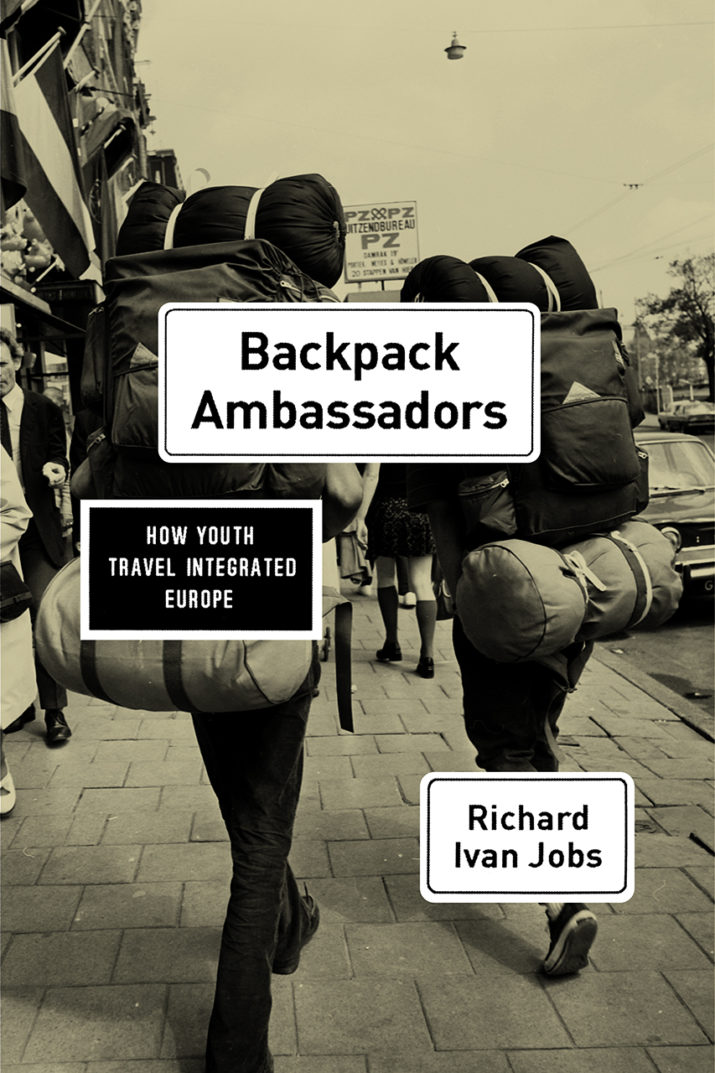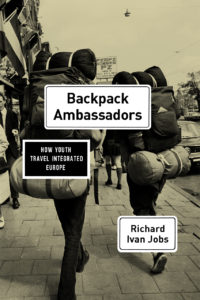

This is part of our special feature on Tourism: People, Places & Mobilities.
The history of Europe after the Second World War is one that must address questions of migration and mobility. At first chaotic and often violent, the movement of displaced persons (DPs), military personnel, victims of totalitarianism and ethnic violence, and POWs crisscrossed Europe, following uncertain and often changing borders, regimes, and circumstances. As treaties were finalized and the four-power occupation of Germany was institutionalized, these movements became more organized, but in no way ended. The last major negotiation for the release of German POWs was brokered in 1955, two years after the death of Josef Stalin, by West German Chancellor Konrad Adenauer, and ethnic Germans and other DP populations continued to be on the move into the early 1960s. As economies stabilized under Marshall Plan aid, labor and consumer manufacture and heavy industry began to require labor. In this context, immigration from former colonies, south and southeastern Europe, Turkey, Africa, and Asia became an important component of Cold War western European stability. In 1965, the three European Communities—European Coal and Steel, European Atomic Energy, and European Economic—passed the Merger Treaty, adopting structures that in 1985 would create the Schengen Area, leading to the ease of mobility, which would eventually characterize the European Union. In contrast, during the same period, the Soviet Bloc further militarized and strengthened borders between East and West. In 1975, the German Democratic Republic implemented plans to construct the fourth and final generation of the Berlin Wall (Grenzmauer ’75), which fortified most of the 93.6 miles of the Berlin border with 45,000 sections of 12 x 3.9 ft reinforced concrete slab.
While travel over Cold War borders became increasingly difficult, within western Europe, the formation of structures and networks facilitating youth travel, both group and individual, encouraged the development of a new kind of generational identity in the postwar era. As Richard Ivan Jobs examines in his latest monograph, Backpack Ambassadors: How Youth Travel Integrated Europe, the creation of a culture of European integration was not solely determined by the geopolitical structures that developed after 1945 to stabilize postwar Europe. As Jobs skillfully develops throughout the book, contact through travel not only created the means by which to move, but also created a set of expectations, experiences, and a network of relationships that shaped a generational view of integration, Europeanization, and personal identity. While youth travel grew in tandem with mass tourism, as well as an increase in political and refugee migration in the late 1980s and early 1990s, privileged populations experienced the freedom of travel more than others. As Jobs emphasizes in the development of his argument:
“Over time, the distinctions of class, gender, and nationality diminished, but those of race and ethnicity persisted… Even among backpackers, the more their travel resembled vagrancy or migration, the more negatively it was perceived by the general public and the more forcefully it was regulated by the state. The integrative elements of their mobility were accompanied by the processes of delimitation and othering that also constituted a form of Europeanization.” (6)
Like all processes of social integration, race, class, age, and other factors are dealt with differently by state and non-state actors, and exclusion accompanies inclusion in this postwar transnational phenomenon as well.
Jobs lays out this transnational story of youth travel, social integration, political rebellion, and cultural rites of passage in five chapters. Chapter 1, “Youth Mobility and the Making of Europe,” examines the commitment of both governmental and private organizations to the reconstruction and rehabilitation of travel infrastructure and the facilitation of youth travel in the immediate postwar period. Building upon the tradition of hosteling, which had its roots in a movement founded by German Robert Schumann in the early twentieth century, the International Youth Hosteling Foundation (IYHF) organized youth to rebuild and reopen youth hostels, primarily in Germany, Belgium, the Netherlands, and France in the immediate postwar. Combined with a commitment to reconstructing rail networks, this commitment to supporting youth travel created a layer of mobility set apart from the movement of DPs, POWs, and other populations affected by the war itself. As the geopolitical line between East and West, especially the border bisecting Berlin, became more contentious and dangerous, with the GDR regime making “flight from the Republic” (Republikflucht) a crime in 1953, the formal and informal networks of travel thickened in western Europe while languishing in the East. Although an Eastern Bloc youth travel culture did develop after the death of Stalin in 1953, the agency afforded to individual youth to travel, camp or squat, make connections, and determine itineraries on the fly became infeasible on the other side of the Iron Curtain.
Chapter 2, “Journeys of Reconciliation,” examines the interaction between state-sanctioned organizations and activities and the growing self-consciousness of youth toward the goals of cultural integration and postwar reconciliation. First organized by the Western occupying forces until 1950, the support and direction of youth exchange and organization, particularly between French and West German youth, was one of the many ways in which governmental organizations tried to facilitate reconciliation. Although parallel attempts were made within and between nations in the Eastern Bloc to mobilize youth power, Western efforts, from the Youth Rally at Loreley in 1951 to the creation of the Franco-German Youth Office in 1963 were meant not only to “facilitate integration” but came to be seen as a “foundation for a future Europe” (85). “State-sanctioned and organized,” these activities were set apart from the emerging phenomenon of individual backpacker travel, which would overtake not only the continent but much of the globe in the late 1960s (87).
Chapters 3 and 4 “Youth Movements” and “Continental Drifters,” both address the role individual youth travelers in the formation of transnational networks, which shaped the trajectory of European integration, while simultaneously forming the center of revolutionary counter-cultural and progressive movements in the 1960s and 1970s. The reconstruction of transportation infrastructure, alongside the relative ease of border crossing facilitated the formation of a “transnational social body of youth.” Represented by political figures including Daniel Cohn-Bendit and Rudi Dutschke, and loose organizations such as the Dutch “provos,” the transnational social body of youth both provided a context within which European youth would both find a cause or purpose with which to travel, and attracted youth from outside the continent, including significant numbers from North America. Chapter 4, “Continental Drifters,” follows the growth of the youth counter-culture movement from the revolutionary summers of 1968 and 1969 into the 1970s, and traces the formation of a backpacking culture within which individuals could freely explore various facets of political, sexual, gender, and cultural fluidity away from the confines of “home.” Immortalized in popular literature, film, and other media, the backpacking ideal became enshrined as a postwar western rite of passage.
Chapter 5, “East of the Wall, South of the Sea,” Jobs uses music and popular culture to trace the various facets of youth mobility from the 1970s into the early years of the post-Cold War. A group known as New Age Travellers “emerged out of the counterculture of the 1960s and the English free festivals of the 1970s,” moving first in large convoys, and later, in smaller groups, creating a “transitory community” (209). Other counterculture “vagabonds” began to explore the southern Mediterranean, North Africa, Asia Minor, and Asia, and spurred by the events of 1968, utilizing colonial overland travel routes toward Kabul, Kathmandu, and the Cameron Highlands in Malaysia.
The primary focus of the chapter, however, is “Eastern Europe, East Germany, and East Berlin” (219). Linking music with the language of mobility, Jobs identifies the importance of individual artists and bands, as well as the creation of the music festival as a transnational nexus for a generation and class defined by its mobility. Nowhere was this more felt than in the German Democratic Republic, where western music, literature, film, and consumer goods were greedily and illegally consumed despite the best efforts of state-sponsored organizations such as the Free German Youth (Freie Deutsche Jugend), who spent occasional nights in East Berlin and other East German cities on the patios of vast concrete slab apartment houses (Plattenbau) turning television antennas away from Western television signals. As the integrity of the Eastern bloc borders began to fail, concerts held by such western rock icons such as David Bowie in West Berlin turned into events during which youth in East Berlin organized in numbers which threatened an already fragile regime. When the wall fell, thousands of young East Germans crossed the border, consuming tremendous amounts of the previously forbidden western products they had been denied.
Although rock concerts by Bowie and Genesis in West Berlin significantly mobilized East German youth and caused significant anxiety for those in power, these events were more emblematic of the greater atmosphere of unrest rather than agents of change themselves. While it may be true that “youth riots at rock concerts and protests about the availability of music were perhaps the most consistent form of popular culture against the regime…” (226), this obscures the role of other youth-centered opposition activities, including the marked increase from 1987 in Republikflucht and formal exit visas to West Germany, as well as the organization of literary, religious, and peace movements in favor of an elimination of travel restrictions.
Backpack Ambassadors is an important example of a transnational and interdisciplinary history which will prove to be an indispensable model for scholars of migration, youth, and/or identity of any period. Using a rich variety of sources, anecdotal, poll-based, cultural, and archival, Jobs creates a vantage point from which to view a myriad of processes that have made, transformed, and redefined what it means to be young, mobile, and European in the postwar age. At the same time, Backpack Ambassadors takes care not to limit its view to those who were absorbed into these movements, but also intentionally delineates those who were excluded as these identities took shape. As Jobs states in his conclusion, “Rights of Passage,” “As international border controls are reintroduced within Europe to stem the flow of migrants, refugees, and security threats, it is ironic that while free mobility was used as a means to achieve stability and national security in this decades after the Second World War, it is now seen as a threat to those achievements” (263). As Brexit looms and refugee flows into Europe continue as a symptom of war and destruction, Jobs’s monograph contains important lessons concerning the role contact has played in stability and the formation of an integrative population, as well as how both inclusion and exclusion emerged from periods of destruction, dislocation, and reconstruction in the twentieth century.
Reviewed by Bethany Hicks, Ouachita Baptist University
Backpack Ambassadors: How Youth Travel Integrated Europe
by Richard Ivan Jobs
Publisher: University of Chicago Press
Paperback / 360 pages / 2017
ISBN: 9780226462035
Published on September 6, 2017.




